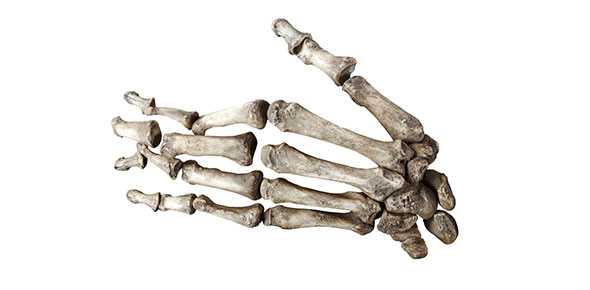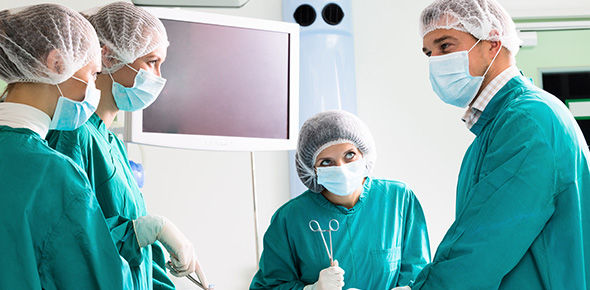Related Flashcards
Related Topics
Cards In This Set
| Front | Back |
|
Briefly describe the differences between woven bone and lamellar bone. Give an example of where you'd see woven bone.
|
Woven (primary) bone = haphazard organisation of collagen fibres. Weaker. Produced when osteoblasts produce osteoid quickly. It is initially what all foetal bones are made of and is seen in adults after fractures or in diseases such as Paget's.Lamellar (secondary bone) = parallel alignment of collagen fibres means it is stronger. Mature, healthy bone.
|
|
Cortical bone is the hard outer layer which gives bone their smooth, white, solid appearance. True or False? This type of bone makes up 80% of skeletal mass and is important for weight-bearing
|
True - due to its high resistance to bending and torsionExtra info: it consists of multiple microscopic columns each called an osteon. These surround a central canal called a Haversian canal. These go in the direction of force applies to the bone. Between the columns are osteocytes which trapped and maintain bone. The osteon canals are connected by Volkmann's canals at right angles. Remember bone contains blood-vessels, is constantly breaking down and rebuilding.
|
|
There are two types of lamellar bone cortical and cancellous (spongy). Which one would you expect at the end of long bones?
|
Cancellous (spongy, trabecular) bone is found at the ends of long bones near joints and in the vertebrae. It is less dense and more flexible than cortical (compact bone)
|
|
Describe the effects that vitamin D has on:a) calcium and phosphate absorption from the small intestineb) PTH release from the parathyroid gland
|
A) Vit D increases Ca and phosphate absorption. These are needed for healthy bone density. b) Vit D inhibits PTH release from the parathyroid. Note: the role of vitamin D in building up bones is quite complicated. Vit D stimulates osteoclast activity but is also important for bone formation as we need it for enough Ca. Take-home: adequate vitamin D is needed for healthy bones.
|
|
Calcitonin is secreted by the parafollicular cells of the thyroid. What is it released in response to?How does it work? (in simple terms)
|
Calcitonin is like the opposite of PTH. It is released in response to high Ca. It works by binding to (the calcitonin receptors of) osteoclasts and making them less active - i.e. less bone is broken down and less Ca is released.
|
|
Vitamin DWhat is it first activated by? This converts it to VD3 - it is then hydroxylated twice. Where does the a) first and b) second hydroxylation take place?
|
Vit D is activated by UV lightIt is hydroxylated in the liver and then the kidney
|
|
PTH is secreted by chief cells in response to low levels of what?
|
Low levels of Ca stimulate PTH release. This is because PTH works to increase resorption of Ca and phosphate - i.e. it will raise serum Ca. It also increases the effects of vit D. Note: remember that high Ca and high Vit D will inhibit PTH release. This helps it keep it in balance.
|
|
Briefly describe in what situations a fracture could heal by primary (direct) fracture healing.
|
Primary healing can occur when there is absolute stability to a fracture. This means that the two fragments are compressed together anatomically excellently, with minimal or no movement, and a good (uncompromised) vascular supply. There will be no callus visible on XR. Extra Info: primary healing occurs when the two fragments of the fracture are compressed in the perfect anatomical position. This can sometimes be achieved using a 'lag screw' - a type of surgical intervention. This occurs by through fragile pathways between the two fragments called 'cutting cones'. osteoclasts travel through first turning over bone, followed by osteoblasts that lay down new bone.
|
|
Secondary healing of fractures aka callus healing is the more common type, because most fractures have a larger gap between the fragments and move a little - 'relative stability'.What are the 4 stages of secondary healing? Explain roughly when each of these stages occur after the fracture?
|
Haematoma Formation (1-7 days): blood vessels rupture, causes inflammatory response, creates fibrin clots and forms a haematoma. Soft Callus (1-3 weeks): a primary callus of granulation tissue (formed of fibroblasts + new blood vessels) replaces the haematoma. Hard Callus (1-4 months): calcification the soft callus occurs. New blood vessels form. By the end of this stage the fracture is 'reunited' by woven bone + people can weight bear. Bone Remodelling (1-2 years): woven bone is replaced by lamellar bone. Woven bone is broken down by osteoclasts and strong, organised lamellar bone is laid down by osteoblasts.
|
 Wrist Fractures - the blue arrow indicates the fracture a) in the image the radial inclination angle (basically the angle of the head of the radius, shown by the white line) is flattened. What angle should it normally be? b) describe briefly what you can see in the lateral view - the pic on the R c) Can you name this type of fracture? What is the most common mechanism of injury to sustain this fracture? |
 A) the angle should be 25O - it is flattened in this fracture. You can also see that at the radioulnar joint, the ulnar is higher than the radius due to radial impaction. b) in the lateral view there is dorsal angulation/displacement of the radius c) this is a Colles fracture - classically sustained with a FOOSH (fall on outstretched hand) with an extended wrist. Pic: in 60% of cases the ulnar styloid process is also fractured. It has a classic 'dinner fork' or 'bayonet' shape to the hand and wrist. |





